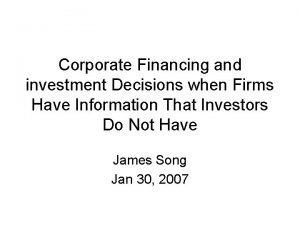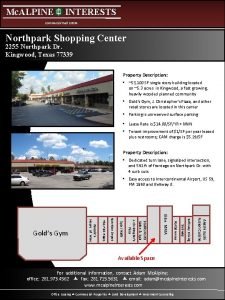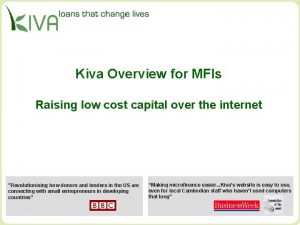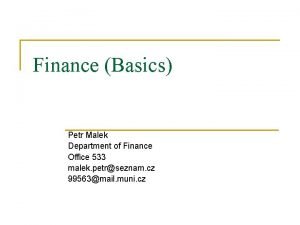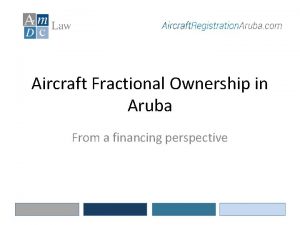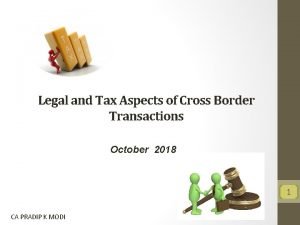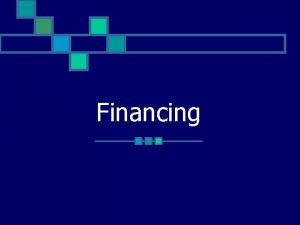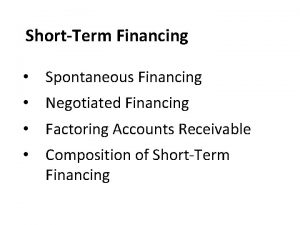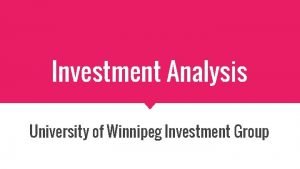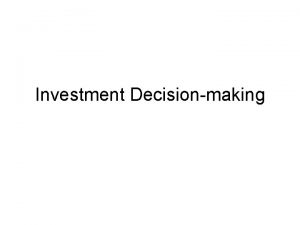Lecture 15 Commercial Financing Lecture 15 Commercial Investment














- Slides: 14

Lecture 15 Commercial Financing

Lecture 15 Commercial Investment Organizations

Commercial Investment Organizations l Limited Partnerships – – Composed of a General Partner and Limited Partners Three primary advantages to a LP l l l – Tax benefits on individual tax returns Limited liability in lawsuits Limited partners do not participate in the management of investments Four tests of a Limited Partnership l l Continuity of the organization Centralization of management Limited Liability Transferability of interests

Commercial Investment Organizations l General Partnership – Three characteristics l l l Test for continuity requires that partnership be dissolved if a partner dies, resigns, or leaves the partnership Each partner has unlimited liability for any obligations of the organization All members of the partnership have equal management rights to commit and bind the whole organization

Commercial Investment Organizations l Corporation – – Can own assets as an organization Required to pay corporate income taxes l Joint Ownership l Individual Ownership

Lecture 11/ Chapter 10 Commercial Lending

Basics of Commercial Lending l l Money lent for real estate that produces income Loan underwriting based on items such as projected incomes, historical earnings and credit of borrowers, location, supply/demand factors in the market, etc. Loans typically larger than residential loans, so terms will vary depending on property and borrower Negative v. Positive Leverage

Commercial Loan Payment Structures l Constant Level Payments – l Fully amortizing; can be paid monthly, quarterly, semiannually, annually Term Payment – Borrower pays debt balance at loan maturity, but pays interest portion over the life of the loan; interest can be paid monthly, quarterly, semi-annually, annually

Commercial Loan Payment Structures l Partial Payment with a Balloon – – – Borrower able to delay a portion of debt until loan maturity Results in lower payment, and higher return over the loan duration Results in additional time to increase property values for re-sale or refinancing benefits at the time of loan maturity (repay debt balance)

Key Financial Standards l Debt-Service Coverage Ratio (DSC) – l Loan-to-Value Ratio (LTV) – l NOI / Annual Debt Obligation Total Loan Amount / Property Value (Sales Price) Overall Capitalization (Cap) Rate: – NOI / Property Value (Sales Price)

Commercial Underwriting Factors of Underwriting: 1. Borrower/Company 2. Project Feasibility (Value greater than development costs) 3. Expected Performance of Project

Commercial Second Mortgages l Higher need in commercial markets due to larger required equity capital contributions l Can be issued by a third party, subject to restrictions of the first mortgage l Higher interest rates than first mortgages (higher risk from having second-lien rights)

Lecture 15 Construction Finance

Construction Loans l Construction Financing – – l Permanent Financing – – – l Short-Term Not a first-lien loan Borrower typically pays interest only during construction Lender pays contractor (in behalf of borrower) in draws Long-Term Begin paying towards principal “Takeout commitment” Gap Financing (if necessary) – Covers non-receipt of income between end of construction and occupancy stabilization of improvement
 Financial decision
Financial decision Corporate financing and investment decisions
Corporate financing and investment decisions Financial contracts
Financial contracts Fixed investment and inventory investment
Fixed investment and inventory investment Alpine commercial investment
Alpine commercial investment Commercial and non commercial food service
Commercial and non commercial food service 01:640:244 lecture notes - lecture 15: plat, idah, farad
01:640:244 lecture notes - lecture 15: plat, idah, farad Project financing definizione
Project financing definizione Risk financing transfer adalah
Risk financing transfer adalah Eca financing
Eca financing Financing vehicle
Financing vehicle What is kiva's approach to micro financing
What is kiva's approach to micro financing Direct financing
Direct financing Fractional ownership financing
Fractional ownership financing Pros and cons of risk financing
Pros and cons of risk financing

